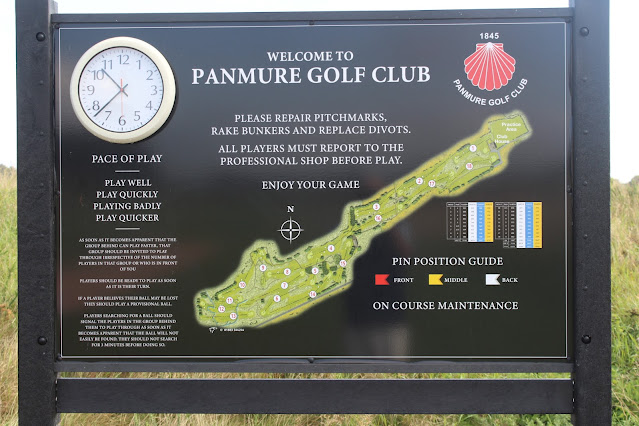On the other side of the railroad tracks, a bit further west than Carnoustie lies Panmure, one of the oldest courses in the world, with origins dating back to 1845. Panmure features an out and back layout, one of the most striking out and back courses I have played since Western Gailes on Scotland's west coast.
Allan Robertson and Alexander Pirie came from St. Andrews and laid out the original nine holes. The course was then known as the Monifieth Links. The club had trouble the first few years with the tenant of the Monifieth Farm who claimed a right of pasturage on the links and complained about the club's use of the land. The club promised to pay for any damages done to the land or to any of his livestock. The tenant farmer did not accept their proposal and brought about legal action. The farmer, James Maule, died in 1852 and the interdict was removed allowing the golfers to chase around their fragile feathery balls once again.
By 1893, there were a number of clubs all playing on Monifieth Golf Course, and due to the congestion it was agreed to look elsewhere, and in 1899 the club moved to its present site at Barry. The original Monifieth course still exists and is directly west of Panmure.
Although the current course is sometimes described as an original Old Tom Morris design, the evidence of such is scant. In the Golf Courses of Old Tom Morris Robert Kroeger says, "it is doubtful that Morris had much input in the early stages of the course. Club minutes don't mention any fee paid to him. It is possible he was traveling to another destination and stopped here as a favor to someone. It seem that the original members should be given credit for the initial construction of the course and its early development."
James Braid was brought in to lengthen the course in 1923, which is set on a narrow strip of land and plays among low rounded sandhills, which make excellent sites for tees and greens. The first six holes go out, all in the same direction into the prevailing wind, number seven is the first hole that plays in a different direction and holes thirteen through eighteen play back in the opposite direction.
The first four holes at Panmure lull you into a sense that the course doesn't have much to it. Three par fours and a par five all running in the same direction, none particularly taxing, especially if played down wind like the conditions on the day I played them, the opposite of what is normally blowing. The course starts to get interesting at the par three 5th which has a punchbowl green.
Panmure's 6th hole, a par four of 414 yards has a blind tee shot . . .
The elevated, well protected green on the 6th
The sixth hole was a favorite of Ben Hogans when he used Panmure as his warmup course before winning the 1953 Open Championship at Carnoustie, which is adjacent to Panmure. He played there for two weeks prior to the Open. At the time the British used a smaller ball, so he was both getting used to links golf and the smaller ball. 1953 would be his only trip to the British Isles. Hogan chose Panmure to practice at because at the time it was an extremely private club and this allowed him to go about his business out of the eye of the eager public and press, who wanted to follow his every move.
During Hogan's visit Panmure did not have a practice area so he did his practicing on the 17th hole, never using more than a dozen balls at a time. One day Hogan asked the head greenkeeper if the blades of the mower could be lowered to shave the green a little to make it more like the speed of the Carnoustie greens. The greenkeeper, William Falconer, replied, "Here's the mower, Mr. Hogan!" Hogan cut the green himself and even cleaned it before giving it back. Hogan was invited to use the dining room and lounge, but he declined, instead taking all his meals in the kitchen because he didn't want to create any trouble, since at the time the club professional wasn't allowed into the clubhouse.
The sixth begins the first of seven holes at the end of the property that, unlike the outward four and the incoming six, play at all different directions on the compass.
The eighth is another hole with a blind tee shot and it is a great 361 risk-reward par four that plays to a well protected green.
Panmure has eleven holes that have out of bounds and with the wind blowing, as it normally is, the course is no pushover.
The clubhouse is a replica of the Royal Calcutta Golf Club in India, and was built in 1871. The reason they have a clubhouse modeled after one in India is because Panmure, and the larger city of Dundee 20 miles away, was a hub of jute (rope or twine) trading with merchants in Calcutta. The club's history states that large numbers of jutewallahs (traders of jute) were Panmure members.
.JPG)








.JPG)











.JPG)


































